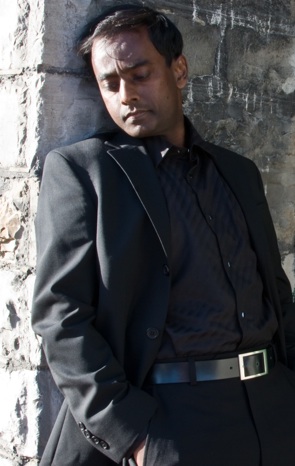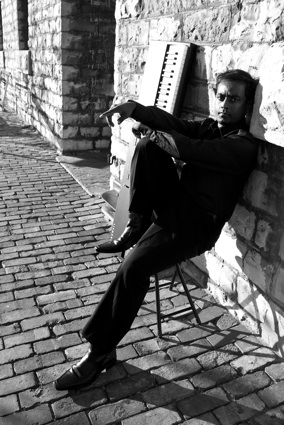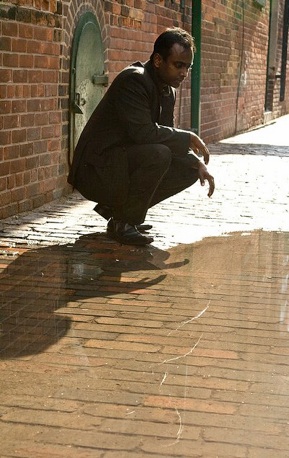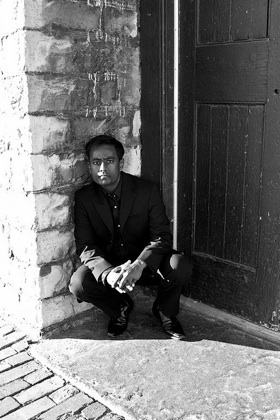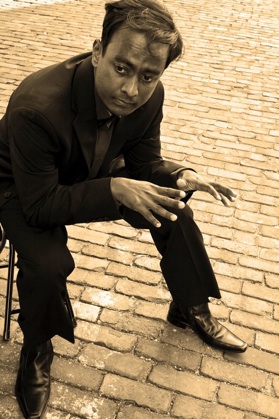It’s too early in the year to give a strong prediction of which albums will be on my
Favorites list for 2011, but I can absolutely guarantee that SAJJAD’s debut,
Where I Belong, will be on that list. Overflowing with vibrant passion and a brilliant array of world instruments and musical styles, SAJJAD has burst on the music scene with a truly amazing album. A native of Bangladesh who grew up in Germany and then came to the US for college, SAJJAD is now working in computer technology in Toronto, financing his musical dreams himself. I was very anxious to learn more about this artist and appreciate SAJJAD’s candor in answering my questions. World, I’m proud to introduce a fantastic new artist, SAJJAD!
KP: Hi SAJJAD! How is Toronto this time of year?
S: First off, I would like to extend a huge THANK YOU to you, Kathy, and everyone else at MainlyPiano.com for this interview. It provides musicians with the opportunity to share experiences and “musical trade secrets” that may help others. To answer your first question, spring in Toronto is wonderful. Canada is such a colorful and ever-changing country throughout the year. Days are mostly sunny now, however the nights fall back to the lower degrees. Within the city, spring usually marks the arrival of multi-cultural festivities and the resuming of construction work. Toronto is changing and quite fast.
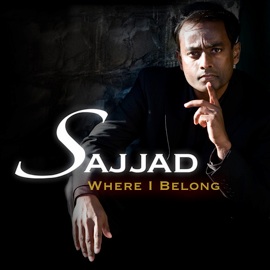
Read Kathy's review
here. Read Michael's review
here.
KP: How has your life changed since releasing Where I Belong a few months ago?
S: Where I Belong is my first commercially-released album, and since the release, I have become busier. When I completed the project and sent it off for publication to digital stores, I thought, "Now the album will travel on by itself." That is far from the truth. You need to take an active role in its promotion when you are still new and do not have agents or promoters backing you. I personally reach out to radio and TV stations to secure airplay and interviews. I am involved with a team of talented individuals to create videos for my songs. A different team is busy with me discussing what a live concert may look like. Learning never stops. My musician friends have a lot of experience in the post-album-release phases and provide me with invaluable lessons.
KP: How did you come up with the title Where I Belong?
S: The title represents my relentless pursuit to become a musician. Despite my university degree and many years of experience in Information Technology, my heart always belonged to music. It is one thing to do what you are told and another to do what you love. As this album represents my best effort to make a transition to where I truly belong, I opted to choose this title.
KP: You have a very impressive roster of international musicians who play on the album. How did you select them and then go about getting them to play on your album?
S: Upon John Jamieson’s (co-producer on the album) advice, I started considering live musicians to complement many of the electronic sounds we were using. If I was going to do that, I wanted to work with the best musicians out there. I just had two criteria in mind as I looked for musicians: first, they had to be open to working with someone who personally does not read or write music notation; second, each musician had to be one of the best on the instruments they played. I also felt that having names such as Ron Allen, John Jamieson, Johannes Linstead, Kevin Fox, and others would add to the credibility of the album. These accomplished artists participate in live recording sessions with others if they feel the project is right. I was virtually unknown at that time, but I believe they loved my music and felt their contribution would add that much more energy to the songs. I was blessed to have them on this album.
KP: How long did it take you to write and record the music for Where I Belong?
S: Most of the demo tracks for Where I Belong had been aging for a number years since some of them were written as early as the 90s. I never intended Where I Belong to grow so much. It was supposed to be a short studio project where I would apply some mastering to my demos and release a CD. John Jamieson heard the potential in the demos and started to show me how we could add instruments, get more complex with the arrangements, bring out some of the dramatic effects in the songs and blend in live instruments. Working at the studio only on weekends and scheduling live musicians took time. From start to finish, the project took about five years.
KP: Along with compelling melodies and the various ethnic influences in your music, most of the pieces have a strong rhythm and energy. Where does that come from?
S: I am glad that you ask. Regardless of the names of the songs, which are difficult to come up with anyway, each song on the album has to do with something universal. The chord structures and melodies are often soaring, moving towards positivity. I felt somewhere between the music and the staff notations lay a drive to constantly move forward and not let go. The only way to represent that drive is to have strong rhythm sections and high-energy beats. I love upbeat and faster tempos. John and I worked very hard to create original rhythms to keep a sense of momentum going within each song.
KP: I like your story about “Far Away” - how you chose Cyndi Richards, and the role Johannes Linstead plays. Do you mind retelling the story?
S: “Far Away” is a tribute to those who maintain long distance relationships. Lovers, parents and children, friends, you name it. Many loved ones today stand apart across oceans and time waiting to come together again. Although initially composed as an instrumental piece, I could hear hints of Dame Shirley Veronica Bassey - most famous for singing the James Bond theme songs. When I shared this with John Jamieson, he immediately had me listen to Cyndi Richards’ voice. Cyndi’s voice is tonally different from Shirley’s, however it has an eerie similarity in terms of the mezzo pitch range and an earthy finality. “Far Away” is sung from a woman’s perspective, lamenting the distance between her and the one she loves. Instead of giving the male counterpart to a singer, I opted to choose Johannes Linstead’s smooth yet manly skills at the Spanish guitar. Between Cyndi’s voice and Johannes’ guitar there is a call and response happening which adds a magical dimension to the song. As gifted as she is with her voice, Cyndi is equally talented with words. She also wrote the lyrics to “Far Away.”
KP: The production quality of the album is incredible - especially for a debut. How were you able to get financial backing for such a big project?
S: I wish to use this answer to encourage aspiring musicians. It is not difficult to produce quality sounding music if you are into it with heart and soul. The key ingredients to this are simple: no matter what others think of your music, you have to believe in it completely. Do as much as you can yourself, like arranging the tracks, selecting the instruments, mixing and balancing sounds, etc. When ready, trust to take your music to others who can add their years of experience to your work. One of the best decisions I ever made was to work with John Jamieson. He breathes music and has a deep appreciation for New Age styles. His suggestions and his studio equipment were invaluable to the overall sound design. I cannot stress enough how much I owe John for making the album sound the way it does. For the most part, my day job, helped me secure the finances I needed for this project. Everything else was the result of pure passion and paying attention to details.
KP: Are you doing all of the promotional work as well?
S: I believe it is important that all aspiring musicians go through the complete life cycle of producing, releasing and promoting an album, doing much of it themselves. It helps you learn at micro levels what the music industry is all about. The other advantage is that you can control the creative process. I have put a lot of foundation myself so I can now relinquish control to others to help me with the promotion. I would be remiss not to acknowledge two very helpful individuals that made the promotional work much easier. First, Tina King (PhotopixByTina), is an amazing photographer who understood my music and my vision and delivered all my promotional photographs. Tina’s pictures captured how I wish to be portrayed. Then comes Denise Wilkins who used her exceptional graphic skills to generate my album cover and other promotional materials. Denise needed little direction and knew instantly what I was aiming for. Last but not least, critical writers such as yourself have reviewed my album and put a good word out for me. I am ever grateful to all of you.
KP: How did you learn about some of the more unusual instruments on the album, such as duduk, erhu, and Uillean pipes?
S: I am quite familiar with the tones of many different instruments. Over the years I trained myself to maintain a thesaurus of sounds, so to speak. Dictated by the emotion that I need to express, I ask myself what type of sound I require. My mind brings back a list of possible instruments. For example, for the song “Where I Belong,” I needed an instrument that sounds like a child crying. It makes sense, as that song is my inner self wanting to belong to music and find every way of getting to it. Cirque du Soleil's Mystere and Dralion soundtracks used the Uilleann pipes in astonishing ways. The Uilleann pipe was thus an excellent choice for “Where I Belong.” If I like a sound I hear, I look up its name and memorize its tonal quality.
KP: Have you done a lot of traveling to be exposed to such a variety of ethnic musical styles?
S: My parents traveled the world and always took all of their children with them no matter what. I lived in and experienced quite a few cultures - Bangladesh, Libya, Germany/UK, USA, Saudi Arabia, and Canada. Toronto being so culturally diverse, I interact a lot with people from other parts of the world that I have never been to. My global experience provides me with universal themes. As I compose, I find that a mix of western and eastern styles or instruments better complement the theme.
KP: Are any of your family members musicians?
S: I am the odd one out - within my immediate and my extended family. No one else has a musical background or plays an instrument. The realization that I wanted to play keyboards did not happen until I was 8 or 9 years old. Until then I just listened to songs and separated the instruments from each other in my mind. I know it can be advantageous to grow up in a musical family and be exposed to music as soon as you are born. You either pick up an instrument or start singing. That said, my non-musical family supported me wholeheartedly, including my kind father who was worried that my interest in music might push aside studies and the prospect of a secure job.
KP: Tell us a bit about your early life.
S: I was born in the overpopulated but scenic city of Dhaka, capital of Bangladesh. Ever ambitious and relentless, my parents were determined to move out of Bangladesh for a different future. I was only months old when I left my home country. From there we went to Germany where we lived for about twelve years. My childhood was filled with happiness and great memories. I cannot say that my family had to struggle a lot. I spent a very insignificant amount of time in my native country compared to time spent in other countries. I graduated from the University of Maryland in 2000 and since then have worked in the corporate industry as an Information Technology Consultant. As the eldest son I would traditionally be expected to send money home to my parents, but my mother asked me to use all of that to fund my musical aspirations. I could not have asked for more supportive parents.
KP: When did you start playing the piano?
S: I started playing the piano much later than usual, in around 1997 at Drake University. I was not able to take my personal keyboard with me when I left for the US so the pianos in the dorm lobbies were a relief. The better pianos were in the music department, mostly reserved for music students. I used to borrow music student ID’s or sneak in with other music students to get access. Once inside, I would spend hours playing and practicing. One of my painful childhood memories was in Germany when that country struggled with racial discrimination. The music teacher would let every student practice the piano except me. He used to say, "For you Sajjad, it is better to watch and learn." I was just happy watching other kids play the piano, not understanding the underlying injustice that was being done.
KP: That is both very sad and shocking. Did you have much formal musical training?
S: I took Music 101 at the University of Maryland in 2001 and got a C. That’s about it. The fear of being confined to rules and principles has always deterred me from taking music classes, but I do not discount the value of such an education. On the contrary, I wish I was able to read and write music notation. I also believe that the long-standing theories of music are undeniably useful. Yet, not knowing if I am doing something right or wrong leaves that one bit of chance that I might create something new.
KP: When did you start composing?
S: I started composing long before I ever laid my hands on a keyboard. The music was all in my mind. I could hear my own drum grooves and bass lines coupled with string and brass sections. I would hum my chorus parts and often use vocables to substitute instrument sounds. I was a human beat box. I got my first keyboard at the age of eleven and that is when the compositions came to life. The music just started pouring out of me. I used my Yamaha Portatone PSR 27 non-stop.
KP: Who and what do you consider to be your musical influences?
S: My father was the person who introduced me to music. He used to record popular songs from the radio onto cassettes and would play them on road trips or at parties. Rock and pop music of the 80s and 90s filled much of my musical tastes – Michael Jackson, Peter Gabriel, Def Leppard, Mike Oldfield, Pat Benatar and more. It was always the melody not the artist that influenced me. That is why my taste in music is broad and covers many genres. As long as I can hold onto a melody line and can feel it, I am influenced by it.
KP: I understand you have a strong background in computer science and technology. Are you working in that field now or have you become a full-time musician?
S: I am in transition at this point. I use my skills in computer technology to generate the finances I need to support my musical ambitions. The amount of devotion needed to balance time between work and music is incredible, however one might be surprised to find many celebrities and musicians today having a secondary source of income. Even they have to spend time away from their passions, and everyone has to start somewhere. In my case, I retain creative control as I finance my own work. Soon I will be able to become a full-time musician.
KP: Are you working on music for album #2?
S: I had enough music for a second album even before I started working on Where I Belong. I intend to release album #2 - we will just have to wait and see when.
KP: How many musical instruments do you play?
S: I play the piano and keyboards.
KP: Who are your favorite composers?
S: The only music I listen to is on the radio while I am driving. Other than that, I seldom listen to any music at all. However, there are some composers whose works I find very appealing - Hans Zimmer, Yanni, Loreena McKennitt, and A. R. Rahman to name a few. I love the simplicity in Bill Wren’s and Marc Enfroy's compositions also.
KP: Who are some of your favorite performers?
S: I enjoy the showmanship of Steve Vai, Herbie Hancock, Yanni, and Rick Wakeman.
KP: Is there a particular philosophy you try to convey in your music?
S: One does not have to understand the music or take any message out of it. If a piece of music moved you to tears or spoke to your heart or just left you undone, it has served its purpose. I wish for my music to be encouraging or at the least be useful in some positive way to the listener. Often an artist’s work is simply inspired from a different source and there is no message to it. Perhaps there is beauty in not knowing what may have inspired that work.
KP: Do you have any concerts/dates lined up?
S: Yes, I am working with a team to put together the starting points for the first concert later this year. We are slowly assembling the band, and I hope to bring musicians that will play some of the ethnic instruments live. As soon as the venue and date is confirmed, we will announce through my official website at www.sajjadmusic.com. However, I will let you in on an exclusive bit of news. A new song is in the works with the aim to be performed for the first time at the concert. The song is called "The Only World I Have."
KP: Is there anything else you’d like to talk about?
S: I am often asked how I knew I wanted to do music. I honestly do not know the answer to this, but I know our time on this planet is limited. Every one of us is in possession of skills and strengths to make much a needed impact on this beautiful planet. I wish every one of us could discover that skill or strength and find a way to use it for the greater good. Finally, I leave readers with a personal quote and many thanks –
"In return of all the breaths we take let us leave a substantial contribution behind, lest the world should see us devoted to ourselves" - SAJJAD
Many thanks to SAJJAD for taking the time for this interview! For more information about him and to hear samples of his music, be sure to visit
his website. You can also learn more about him on his
Artist Page on MainlyPiano.com.
Kathy Parsons
May 2011

